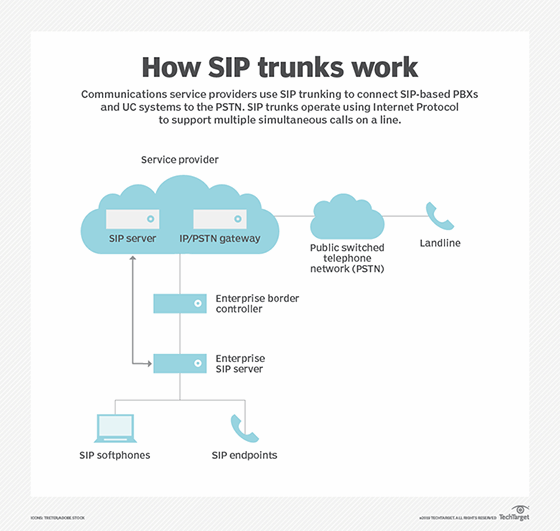
leungchopan - Fotolia
SIP trunking vs. VoIP: What's the difference?
SIP trunking and VoIP share some similarities, but they have key differences in origin and functions. Learn how together they form the cornerstone of IP telephony.
The Session Initiation Protocol and voice over IP are two complementary, yet distinctive, technologies that have helped underpin internet communications. Both SIP and VoIP are core components in facilitating voice communications over the internet, but it's important to know their differences.
Let's examine SIP trunking vs. VoIP and the role each plays in the development of unified communications and other enterprise collaboration platforms.
What is VoIP?
VoIP is perhaps the most important acronym in the communications space, as every real-time application used in the workplace today follows in VoIP's footsteps. VoIP technology was commercialized in 1995, and it represented a radical breakthrough that enabled real-time transmission of voice over a data network.
Until that time, all fixed-line telephony was carried over purpose-built voice networks operated by incumbent phone companies. Collectively, these networks comprised the public switched telephone network (PSTN). This foundation provided rock-solid 99.999% reliability, but the incumbents' monopoly on telephone service led to VoIP becoming a viable alternative.
For enterprises, VoIP is often associated with phone systems -- and for good reason. Legacy telephone service has long been defined by phone lines connected by a trunking service -- namely T1 lines -- to a premises-based private branch exchange (PBX) system. Since the 1970s, PBX has been the standard telephone network architecture in business environments, at least until VoIP came along. That brings us to SIP.
SIP is closely related to VoIP, but there are important distinctions. SIP is a set of rules -- protocols -- that enables the creation of a session running over a data network, such as the internet. A SIP session could be voice-based, in which case it's analogous to making a phone call over the PSTN.
But SIP supports other media modes as well, such as video and instant messaging. VoIP, by contrast, is only about voice. When someone makes a VoIP call, SIP will be one of the protocols used to enable calls over the data network. And although both SIP and VoIP have the term protocol in their names, SIP alone is a true protocol. VoIP calls are made over the internet, and thus comprise a set of voice technologies that themselves support various internet protocols. That support is what lets calls traverse a data network.
What is SIP trunking?
SIP is a set of protocols that enables communications over IP networks, including telephony. SIP trunking provides the connectivity between endpoints and cloud-based communication services. The analog equivalent would be physical trunks, known as primary rate interface (PRI), that connect PBXs to the PSTN. PRIs carry only voice traffic while SIP trunks carry all forms of data traffic, including voice, in the form of VoIP. Other advantages include the following:
- SIP trunking gives businesses a more cost-effective approach for telephony. The alternative would require a separate phone line for each employee -- an expensive and complex proposition.
- SIP trunks are virtual, making it much easier to scale and support distributed operations. Finally, unlike voice-only PRIs, SIP trunks support all types of data traffic, making it the right trunking model for unified communications (UC).
Similarities between SIP trunking and VoIP
SIP trunking and VoIP are the cornerstones of IP telephony. Together, they provide the foundation for a variety of capabilities aimed at helping companies save money and become more productive. They also help fuel the growth of UC, which integrates voice communications with other communications modes to enable new forms of collaboration. These capabilities are simply not possible using traditional telephone networks or routing calls over the PSTN.
It's also important to note that VoIP is a phone service -- like dial tone -- to which businesses subscribe, just as they would with a time-division multiplexing (TDM) service for PSTN-based telephony.
- VoIP ushered in the IP PBX, now the successor for premises-based phone systems.
- SIP trunking is the successor to T1 as the de facto trunking service for enterprise telephony.
- SIP is one of the protocols used for VoIP.
- SIP trunking provides the actual connection between the telephony endpoint, such as an IP PBX or SIP phone, and a data network, like the internet, over which the VoIP services travel.

Differences between SIP trunking and VoIP
SIP trunks differ from PBX trunks because they carry all forms of media -- not just voice. SIP trunks are data-centric; they transmit packets that could carry voice, data or video. This makes them more flexible than PBX trunks, which are limited to voice and telephone service. They are also more cost-effective, since adding voice to a SIP trunk reduces the need for legacy connectivity.
Once voice is added to a SIP trunking service, an enterprise can support all communications applications end to end, an ideal environment for UC. This moves telephony off the voice-only island of TDM and into the integrated world of UC, where it can be more effective in supporting the needs of today's workers.
While these two elements work very well together, SIP trunking and VoIP are distinct. Consider the following:
- SIP trunks are connections that provide voice to your phone system.
- Legacy-based PBX trunks only carry voice; they are expensive and inflexible, but very reliable.
- VoIP is one type of voice application that runs over SIP trunks and connects to external networks that support packetized voice. VoIP can also be routed over PBX trunks via a media gateway, but to take full advantage of VoIP's capabilities, businesses will deploy SIP trunks and typically route these calls via a session border controller, and then over a data network like the internet.
SIP trunking vs. VoIP: The bottom line
Both SIP trunking and VoIP are core building blocks of IP-based communications. Decades ago, IP communications was just about telephony. Today, IP communications reflects all modes of communications that run over a common data network.
Telephony remains an essential business communication tool -- for which you need both SIP trunking and VoIP -- but it is no longer siloed away from everything else as legacy telephony used to be. Today's employees need multichannel capabilities and integrated platforms to be productive. That's what UC delivers, thanks to VoIP and SIP trunking.








